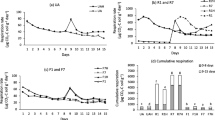Summary
The effects of 15 years of field applications of 2,4-dichlorophenoxy acetate (2,4-D) on soil microbial population and biochemical processes were studied in a field cropped with maize followed by potatoes. Amine or ester formulations at the rate of 0.95 kg 2,4-D per hectare applied in May and October every year. Fungal, bacterial, and actinomycete populations, and microbial biomass C and N were reduced by the 2,4-D treatment, the reduction being more marked where the ester was used. N mineralization, nitrification, and potentially mineralizable N were reduced by the 2,4-D ester only, while urease activity was depressed by both formulations. Dehydrogenase activity and soil microbial respiration tended to be temporarily increased by the amine, but were reduced substantially by the ester, indicating that the ester probably interfered with nutrient cycling.
Similar content being viewed by others
References
Breazeale FW, Camper ND (1970) Bacterial, fungal and actinomycete populations in soils receiving repeated applications of 2,4-dichloro-phenoxy acetic acid and trifluralin. Appl Microbiol 19:369–380
Campbell CA, Myers RJK, Weier K (1981) Nitrogen mineralization potentials, decomposition rates and their relationship to temperature for five Queensland soils. Aust J Soil Res 19:323–332
Carter MR, Rennie DA (1982) Changes in soil quality under zero tillage forming systems: Distribution of microbial biomass and mineralizable C and N potentials. Can J Soil Sci 62:587–597
Cochran WG, Cox GM (1957) Experimental designs, 2nd edn. John Wiley & Sons, New York
Curry JP (1986) Effects of management on soil decomposers and decomposition processes in grassland. In: Mitchell MJ, Nakos JP (eds) Microfloral and Faunal Interactions in Natural and Agroecosystems. Dr W Junk Publishers, Dordrecht, pp 350–398
Dec J, Bollag JM (1988) Microbial release and degradation of catechol and chlorophenols bound to synthetic humic acid. Soil Sci Soc Am J 52:1366–1371
Fryer JD (1981) Herbicides: Do they affect soil fertility? Span 2:5–10
Greaves MP (1979) Long-term effects of herbicides on soil microorganisms. Ann Appl Biol 91:129–132
Greaves MP, Malkomes HP (1980) Effects on soil microflora. In: Hance RJ (ed) Interactions between herbicides and the soil. Academic Press, London, pp 223–253
Jenkinson DS, Powlson DS (1976) The effects of biocidal treatments on metabolism in soil V A method for measuring soil biomass. Soil Biol Biochem 8:209–213
Jensen V (1968) The plate count method. In: Gray TRG, Parkinson D (eds) The ecology of soil bacteria: An international symposium. Liverpool University Press Liverpool, pp 158–170
Johnson LF, Curl EA (1972) Methods for research on ecology of soil borne plant pathogens. Burges Publication CO, Minneapolis, pp 240–252
Kiss S, Drafan-Bularda M, Radulescu D (1975) Biological significance of enzymes accumulated in soil. Adv Agron 27:25–87
Kuster E, Williams ST (1964) Selection of media for isolation of streoptomycetes. Nature (London). 202:928–929
Martin JP (1950) Use of acid, Rose Bengal and streptomycin in the plate method for estimation of soil fungi. Soil Sci 69:215–232
Narayana Rao VVS (1988) Effects of pesticides on ammonification In: Lal R, Lal S (eds) Pesticides and Nitrogen Cycle, vol 2. CRC Press, Boca-Raton, Florida, pp 1–41
Olson BM, Lindwall CW (1991) Soil microbial activity under chemical fallow conditions: Effects of 2,4-D and glyphosate. Soil Biol Biochem 23:1071–1075
Ou LT, Davidson JM, Rothwell DF (1978) Response of soil microflora to high 2,4-D applications. Soil Biol Biochem 10:443–445
Pastor J, Aber JD, McClaugherty CA, Melillo JM (1984) Aboveground prodution and N and P cycling along a nitrogen mineralization gradient on Blackhawk Island, Wisconsin, Ecology 65:256–268
Ross DJ (1970) Effects of storage on dehydrogenase activities of soils. Soil Biol Biochem 2:55–61
Schuster E, Schroder D (1990) Side-effects of sequentially-applied pesticides on non-target soil microorganisms: Field experiments. Soil Biol Biochem 22:367–373
Singh K (1971) Effects of 2,4-D and simazins on total bacteria, fungi Azotobacter ammonification and nitrification under field conditions. Pesticides 5:14–17
Singh JS, Raghubanshi AS, Singh RS, Srivastava SC (1989) Microbial biomass acts as a source of plant nutrient in dry tropical forest and savanna. Nature (London) 399:499–500
Singh RS, Raghubanshi AS, Singh JS (1991) Nitrogen-mineralization in dry tropical savanna: Effects of burning and grazing. Soil Biol Biochem 23:269–273
Smith AE, Aubin AJ, Biederbeck VO (1989) Effect of long-term 2,4-D and MCPA field applications on soil residues and their rates of breakdown. J Environ Qual 18:299–302
Soulas G, Chaussod R, Verguet A (1984) Chloroform fumigation as a means of determining the size of specialised soil microbial populations: Applications to pesticide-degrading organisms. Soil. Biol Biochem 16:447–501
Stanford G, Smith SJ (1972) N-mineralization potentials of soils. Soil Sci Soc Am Proc 36:465–472
Stojanovic BJ, Kennedy MV, Shuman FL (1972) Edaphic aspects of the disposal of unused pesticides, pesticide wastes, and pesticide containers. J Environ Qual 1:54–62
Stott DE, Martin JP, Focht DD, Haider K (1983) Biodegradation, stabilization in humus and incorporation into soil biomass of 2,4-D and chlorocatechol carbons. Soil Sci Soc Am J 47:66–70
Voets JP, Moerschman P, Verstraete W (1974) Soil microbiological and biochemical effects of long-term atrazine application. Soil Biol Biochem 6:149–152
Voroney RP, Paul E (1984) Determination of kc and kn in situ for calibration of the chloroform fumigation incubation method. Soil Biol Biochem 16:9–14
Wardle DA, Parkinson D (1990) Effects of three herbicides on soil microbial biomass and activity. Plant and Soil 122:21–28
Wilson RG, Cheng HH (1978) Fate of 2,4-D in a Naff silt loam soil. J Environ Qual 7:381–386
Zantua MI, Bremner JM (1975) Comparison of methods of assaying urease activity in soils. Soil Biol Biochem 7:291–295
Author information
Authors and Affiliations
Rights and permissions
About this article
Cite this article
Narain Rai, J.P. Effects of long-term 2,4-D application on microbial populations and biochemical processes in cultivated soil. Biol Fertil Soils 13, 187–191 (1992). https://doi.org/10.1007/BF00336278
Received:
Issue Date:
DOI: https://doi.org/10.1007/BF00336278




